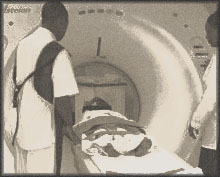CT after Concussion
Computerized Tomography – CT Scan
 CT after concussion or CAT scanning is the primary neuroimaging technique in the initial evaluation of the acute head trauma patient.
CT after concussion or CAT scanning is the primary neuroimaging technique in the initial evaluation of the acute head trauma patient.
CT imaging uses a computer to digitally construct an image based upon the measurement of the absorption of X-rays through the brain. If there is evidence of head trauma the ER will almost order a CT immediately to check for evidence of brain bleeding, brain swelling, etc. In the case that their results are positive it is most likely there will be some kind of brain injury. Just how much and how long recovery is will not be told by the CT results.
Pros:
 CT is fast, which makes it preferable to MRI for acute cases.
CT is fast, which makes it preferable to MRI for acute cases.- CT is available in almost all acute care facilities.
- CT can be administered while the patient is hooked up to IV’s or other ICU equipment.
- CT does a good job of identifying intracranial bleeding/mass effect.
- CT is best for fractures, superior to X-ray.
- CT is more sensitive to certain life threatening conditions than MRI in the first 72 hours.
- It can be done with and without contrast.
Contra:
- CT is a structural test.
- CT has poorer resolution.
- CT has little post acute value.
If the brain damage is too the cells in the case of shear (sliding of the brain layers) brain injury, the CT could have negative results when there actually is brain injury going on. Brain injury is not always apparent at the time of the injury and because a CT scan returns negative results, brain injury can go undiagnosed. Some could be diagnosed if they would require a follow up CT after concussion like the following day. The insurance companies would probably strongly oppose such scans.
See Also CT Resources Brain MRI